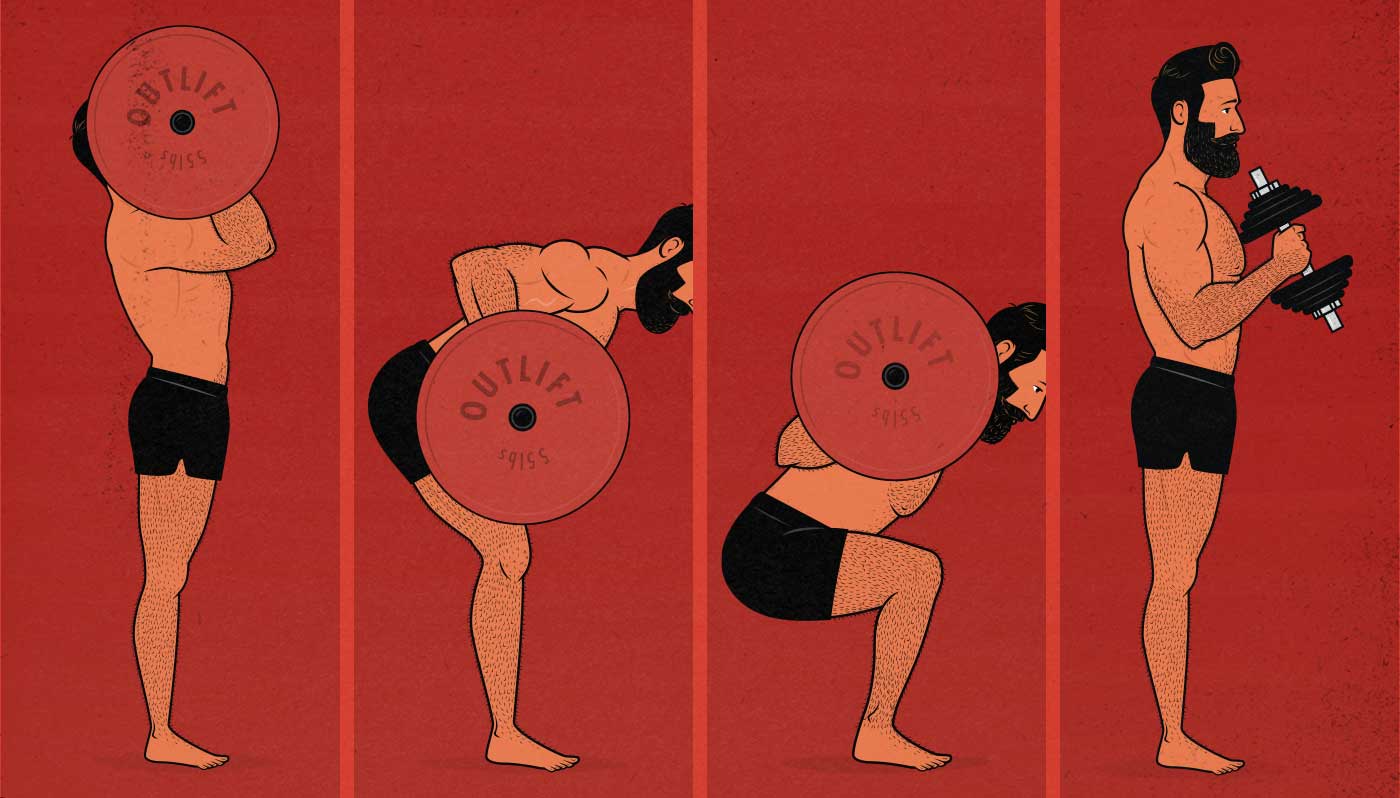Want to sculpt a stronger, more muscular physique? This 4-day workout split is your roadmap to success! We’ll show you exactly how to target your muscles for maximum growth, with a detailed plan you can start today.
Get ready to ditch ineffective workouts and unlock the secrets of muscle-building efficiency. This guide breaks down everything you need – exercises, techniques, and answers to all your workout split questions.
Are you ready for a transformation? By the end of this article, you’ll be armed with the knowledge and program to get the results you crave!
Jump to:
So why a 4 day workout split?
There are lots of different workout splits. Upper/Lower. Push/Pull. 3 day, 4 day, 5 day and the like. Whilst they’re all effective when done correctly, some programs just get it wrong. They don’t balance volume and intensity with rest. Sometimes they’re not mechanically balanced, leading to injuries. Other times the exercise selection is poor.
This 4 day workout split will avoid all of these points and help you pack on muscle…
4 Day Workout Split – The Workouts
Without further ado, let’s get started with the 4 workouts:
Chest and Triceps

Bench press 4 x 10
The king of the chest exercises, I couldn’t write a 4 day workout split without including the bench press! It’s a great way to develop upper body strength, and it builds the chest, shoulders and triceps. Perfect for beginner lifters, intermediate lifters and advanced lifters alike.
Pec Fly 4 x 10
This was an Arnold favorite for chest day. The chest fly is a great way to hit the chest muscles, and stretch them throughout the lift. In addition, it’ll open up the shoulder joint, which helps to maintain joint health and stability. It’s a way to still build muscle but with a different movement pattern. The eccentric contraction of the pectoral muscles is key to this exercise working.
Dips 4 x 10
I like this exercise because it’s a way to stimulate muscle growth across many of the major muscles in the upper body. As well as building strength, it’s another way to stretch the chest and shoulders. It’s a bodyweight exercise that you can make more challenging with the addition of weight. Place a dumbbell between your feet, or wear a weight belt to add the weight.
Decline dumbbell bench press 3 x 8
A decline dumbbell bench press is a perfect way to hit the lower chest. Whilst pressing movements are a great way to build muscle mass on the chest, shoulders and triceps, you need to include decline presses to hit the lower chest. Using dumbbells for this increases the range of motion significantly. This increases the time under tension and the strength gains.
Tricep pushdown 3 x 15
This is one of my favorite isolation exercises for the triceps. It allows you to keep tension on the triceps for a long time, it complements the compound exercises (stronger triceps = better pressing), and works you in a higher rep range (15-20 reps stimulate slow twitch muscle fibers). The tricep pushdown a perfect accessory movement to compliment this workout.
Legs and Abs
Back squats 4 x 12
The back squat is the most effective of all the leg exercises. It’s a great barbell exercise and is super effective when it comes to building muscle. You can lift heavy weights, or lighter weights with a higher training frequency with squats.
Split squats 4 x 10 (per side)
The split squat is a real favorite of mine on leg day, because it’s unilateral, so it strengthens both sides equally. It’s also a great way to isolate the quads and glutes, focussing on the larger muscle groups in the legs. It’s also a good way to stretch the hip flexors as well.
Stiff legged deadlift 4 x 8
I think this is one of the best and most efficient lower body exercises. It strengthens the hamstrings, and forces them to stretch. It’s great for the glutes and lower back too. I like the exercise because it’s a simple enough technique to learn, and has major strength and injury prevention benefits.
Calf raises 5 x 25
The calf raise is a rare thing – an isolation exercise on lower body day! The muscle fibers in the calves are generally slow twitch, designed for high rep work. We get around this by hitting them with high training volume. We’re going for five sets of the calf raise, designed to really challenge the muscle.
Hanging leg raises 3 x 10
The hanging leg raise is a super effective abdominal exercise. As well as hitting the abs hard, it’s also a great way to train the grip. The passive hang is an effective lat stretch, helping to improve shoulder health as well.
Cable crunches 3 x 12
The cable crunch is a way to strength train the abdominal muscles without resorting to excess spinal flexion. The abdominal muscles respond well to heavy resistance training,. adding muscle mass through loading.
Back and Biceps

Chin ups 4 x 8
The chin up is a great exercise for the back and biceps. The underhand grip hits the biceps well, and the vertical pull is great for the lats. It’s a more mechanically-advantageous movement than pull ups, making it arguably a more efficient exercise. I always include the chin up in an upper body workout program.
Deadlifts 5 x 8
To many people, the deadlift is the king of the exercises. It’s arguably the most efficient of the compound movements, hitting almost the entire body with one single exercise. By pulling a weight from the floor to your hips, you stimulate muscle mass all up the legs, back and core.
Seated cable row 4 x 10
I like this exercise because it allows you to increase the range of movement relative to a barbell row. With the muscle fibers in a stretched position, you can force them to work hard for longer. This increases time under tension and increases the rate of muscle growth.
Dumbbell seal row 4 x 12
The unilateral aspect of this exercise makes it a perfect addition to this pull day workout. You lift through a full range of motion, there’s no lower back stress (unlike with bent over rows) and it packs on muscle mass quickly. It’s a low risk, high reward exercise for your upper body.
Lat Pull Down 3 x 10
The lat pull down is an exercise that effectively allows you to train the lats with a vertical pull movement. It’s a similar movement to the chin up, so helps to increase the rate of progressive overload in the lats. Whilst some people prefer pull ups, I think the lat pulldown is more achievable for most people who are already fatigued.
Incline dumbbell bicep curl 4 x 12
The incline dumbbell bicep curl is a way to directly target the biceps, and reduce the chances of cheating the reps. There’s no back movement allowed thanks to the bench, and the full extension at the bottom increases the range of movement. It’s a great way to hit the biceps with extra volume.
Shoulders and abs

Military press 4 x 10
No push day is complete with a pressing motion. In this case, it’s the military press. Upper body workouts are most effective when they include both a horizontal and vertical press. Thanks to it effectively building muscle mass in the shoulders, chest and arms, the military press is one of the main compound movements for the upper body.
Lat raises 3 x 12
Dumbbell lateral raises are an exercise the majority of people will be familiar with. They’re a simple but effective way to target the medial delts. Anterior deltoids are trained well with pressing movements, but the medial deltoids take a little more targeting. A lat raise hits these muscle fibers effectively, increasing the rate of muscle growth in the shoulder.
Upright row 3 x 15
I tend not to perform this exercise with heavy weight, because some people can suffer with shoulder impingement if they lift too heavy. Instead, I treat it as a high rep accessory movement. Upper body workouts involve multiple different movement directions, so these extra sets and reps will contribute to the progressive overload you need to build muscle.
Chest supported rear delt fly 4 x 15-20
Personally I prefer rear delt fly to be chest supported. This takes stress off the lower back, allowing you to get extra reps out on the upper body workout. The rear deltoids are small muscles, so I don’t bother with heavy weight. Instead, I shoot for high reps. Accessory exercises such as this one aren’t about building massive strength – they’re about building stability in most cases.
Side plank 2 x 45 seconds per side
The side plank is a great way to add oblique work to your training sessions. We train abs a couple of days per week on the program, but in order to maximize the effectiveness of these exercises we can’t repeat the same movement patterns. The side plank is great additional exercise to keep the core strong.
Barbell ab roll out 4 x 10
No workout program will be fully effective if it leaves a movement pattern untouched. One of the best abdominal exercises I know is the barbell ab roll out. It’s anti-extension, it stretches and strengthens the upper body and it’s a great addition to a workout routine. It also limits lower back stress.
4 Day Split FAQ’s
Here’s a few questions that commonly come up when we discuss 4 day split workout routines…
Why a 4 day split?
A 4-day workout program allows focused workouts on specific muscle groups. This ensures gains in muscle mass, and recovery time between sessions. It means we can hit high numbers of sets per exercise because we’re only training a body part one or two days per week. Each single workout can be pushed to a high intensity.
If you do too many consecutive workouts you allow fatigue to build up.
How do I balance work and recovery
I like a 2 on, 1 off, 2 on, 2 off pattern. What this means is my clients train a couple of days, take a day of rest, hit a couple more days then take a weekend off.
I find that this allows adequate rest days, which are needed with a 4 day workout routine. If you were to hit too many consecutive workouts, or not allow enough rest between workouts you risk overtraining. Prioritize proper nutrition and sleep. They are crucial for muscle protein synthesis.
Listen to your body and adjust as needed.
Rest is vital – not a luxury. This was found in a 2020 study titled Intramuscular mechanisms of overtraining. Researchers investigating overtraining syndrome and its effect on muscle performance concluded that…
Skeletal muscle accounts for approximately 40% of your body weight and is essential for our ability to move and breath. Here we showed that skeletal muscle is an important contributor to overtraining syndrome (OTS) with the long-lasting prolonged low-frequency force depression developed following exhaustive exercise as a potentially potent inducer of skeletal muscle weakness in OTS.
At least a couple of times per week, take a rest. This rest between workouts means you’re fresh for the next one.
How do the different workouts compliment each other?
Lots of exercises overlap. Take a deadlift for example. It’s performed on a back day here, but it’s also using the legs. A bench press is done on chest day, but it’s using the shoulders.
In practice, the workout schedule means that although we don’t directly train the same body part day after day, they are being used in different workouts. This increases muscle gains without putting too much strain on the body. It also gives us time to include lots of exercise variety.

How do I program the training days?
You can do them in the order that suits you. If the order here doesn’t work for you or your schedule, just change it.
Training too much will impact muscle gains and recovery. There’s three workouts here with mostly upper body training, so I’d urge you to split these up with the leg day in between them.
What about cardio?
Cardio can be added on non-strength training days or at the end of your workouts, but it’s not mandatory for this program. Adjust based on your goals and preferences. You need to allow plenty of time to rest, so make sure your cardio doesn’t take too long (20 minutes, 2-3 times per week is plenty).
Contrary to popular belief, cardio can actually help you to build muscle. A 2014 study titled ‘Skeletal Muscle Hypertrophy after Aerobic Exercise Training‘ concluded…
‘This review provides considerable evidence to support that aerobic exercise training can produce skeletal muscle hypertrophy.’
This means don’t shy away from an appropriate amount of cardio training because you’re worried about your gains. Just make sure it doesn’t impact your rest and recovery!
Final thoughts on the 4 day workout split…
Consistency and dedication are vital for transforming your physique. This 4-day split program, coupled with proper nutrition and rest, can help you achieve the results you’ve been working hard for.
Stick with it, and watch your body transform before your eyes!














